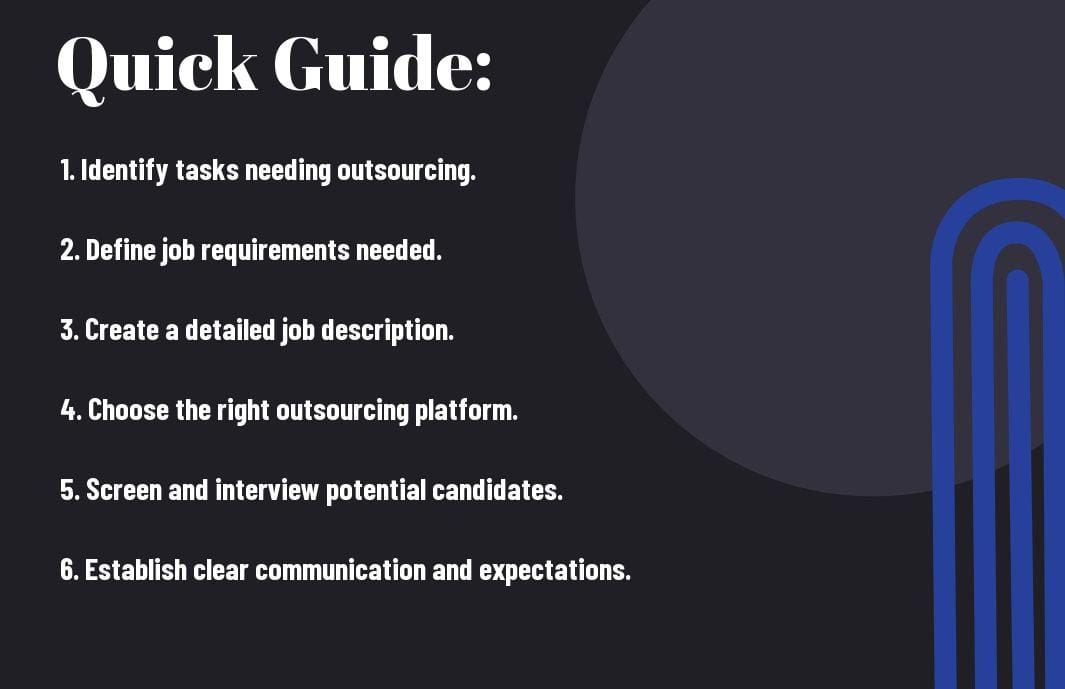Outsourcing is a strategic decision many businesses make to optimize resources, cut costs, and access specialized skills. In this comprehensive guide, we will walk you through the imperative steps of hiring and outsourcing for your business, covering everything from determining your needs and budget to finding the right talent and managing remote teams effectively. Learn to avoid common pitfalls, such as miscommunications, cultural differences, and quality control issues, while maximizing the numerous benefits of outsourcing like scalability, efficiency, and flexibility. Whether you’re a startup looking to expand your team or a seasoned entrepreneur aiming to streamline operations, this ultimate guide will equip you with the knowledge and tools needed to make informed decisions and succeed in the ever-evolving business landscape.
Key Takeaways:
- Outsourcing can save time and money: Outsourcing tasks that are time-consuming or require specific expertise can help your business run more efficiently and cost-effectively.
- Effective hiring processes are important: Having a clear job description, conducting thorough interviews, and checking references are crucial steps in hiring the right candidates for your business.
- Building a reliable team is key: Trusting your outsourced team members and fostering good communication will lead to successful partnerships and business growth.

Deciding When to Hire and When to Outsource
Factors to Consider Before Making a Decision
Some business owners may find themselves at a crossroads when deciding whether to hire new employees or outsource tasks. It’s necessary to evaluate several key factors before making a decision. Consider the cost implications, the expertise required, the timeline for completion, and the availability of resources.
- Cost implications of hiring versus outsourcing
- Expertise required for the task
- Timeline for completion
- Availability of resources
Any decision should align with the long-term goals and vision of the business, ensuring that the chosen path will contribute to overall growth and success.
The Cost-Benefit Analysis of Hiring vs. Outsourcing
Even a small business must consider the cost-benefit analysis of hiring versus outsourcing. Hiring employees may involve overhead costs like salaries, benefits, and training, while outsourcing may provide cost-effective solutions with no long-term commitments. Making a well-informed decision based on a detailed cost-benefit analysis is crucial for the financial health of the business.
Types of Hiring and Outsourcing
After establishing the need to hire or outsource for your business, it’s crucial to understand the different types of hiring and outsourcing options available. This knowledge will help you make informed decisions and choose the best strategy for your specific needs.
| Types of Employment Contracts and Hiring | Types of Outsourcing Models and Services |
| Permanent | Onshore |
| Temporary | Nearshore |
| Freelance | Offshore |
| Internship | Cloud Computing |
| Contractual | Business Process Outsourcing (BPO) |
Types of Employment Contracts and Hiring
An understanding of different types of employment contracts and hiring options is vital for any business owner. Whether you opt for permanent employees, temporary workers, freelancers, interns, or contractual agreements, each type has its own benefits and considerations. Perceiving the differences between these options will help you create a diverse and effective team.
Types of Outsourcing Models and Services
Models of outsourcing like onshore, nearshore, and offshore provide businesses with various options to delegate tasks to external partners. Additionally, services like cloud computing and business process outsourcing (BPO) offer specialized assistance for specific business needs. Thou understanding the differences between these models and services is crucial for successful outsourcing partnerships.
Types of Outsourcing Models and Services
Another critical aspect to consider when it comes to outsourcing is the different models and services available in the market. Understanding the various options like onshore, nearshore, and offshore can help you make informed decisions. Thou delving into services such as cloud computing and business process outsourcing (BPO) can provide specialized support for your business needs.
| Types of Employment Contracts and Hiring | Types of Outsourcing Models and Services |
| Permanent | Onshore |
| Temporary | Nearshore |
| Freelance | Offshore |
| Internship | Cloud Computing |
| Contractual | Business Process Outsourcing (BPO) |
Step-by-Step Guide to Hiring
Once again, let’s examine the process of hiring the perfect candidates for your business. To streamline your hiring process, it is imperative to follow a structured approach. Below is a breakdown of the step-by-step guide to make your hiring process efficient and effective.
| Step 1: Craft a Compelling Job Description | Step 2: Promote the Job Opening |
| Step 3: Review Resumes and Shortlist Candidates | Step 4: Conduct Interviews and Assessments |
| Step 5: Perform Background Checks | Step 6: Make the Job Offer |
Tips for Crafting the Perfect Job Description
Assuming you want to attract the right candidates, your job description should be clear, concise, and engaging. Use keywords to describe the role and responsibilities effectively. Highlight the company culture and perks to entice top talent. Perceiving the job from the candidate’s perspective will help you create a job description that resonates with potential applicants.
The Hiring Process: Interviews, Assessments, and Background Checks
Assessments, interviews, and background checks are crucial steps in the hiring process. Conducting thorough interviews to assess a candidate’s skills, experience, and cultural fit is imperative. Assessments help evaluate a candidate’s abilities and compatibility with the role. Background checks provide security and ensure the candidate’s credibility. Process all these steps diligently to make informed hiring decisions.

Step-by-Step Guide to Outsourcing
Keep track of your needs and budget when considering outsourcing for your business. It’s necessary to find the right partners who can help you achieve your goals effectively and efficiently.
| Tips for Finding Reliable Outsourcing Partners | Managing Outsourced Teams: Communication and Quality Control |
Tips for Finding Reliable Outsourcing Partners
Little due diligence goes a long way in finding reliable outsourcing partners. Look for companies with a proven track record, read client testimonials, and ask for referrals. Choose partners who understand your industry and have experience in the services you need. The key is to establish trust and open communication from the start to ensure a successful partnership.
Managing Outsourced Teams: Communication and Quality Control
Finding the right balance between communication and quality control is crucial when managing outsourced teams. Regular check-ins, clear expectations, and defined goals are necessary for ensuring that the work is completed to your standards. Utilize project management tools and systems to track progress, share feedback, and maintain a high level of visibility into the outsourcing process.
Step-by-Step, effective communication and quality control are the cornerstone of successfully managing outsourced teams. By staying proactively involved in the process and maintaining clear expectations, you can prevent misunderstandings and ensure deliverables meet your standards.
The Pros and Cons of Hiring and Outsourcing
| Advantages of Hiring | Disadvantages of Hiring |
| Direct control over employees | Higher costs for salaries and benefits |
| Develop in-house expertise | Time-consuming recruitment process |
| Cultural alignment with company values | Potential for limited skillsets |
| Promotes team collaboration and morale | Legal responsibilities as an employer |
| Opportunities for career development | Risks of turnover and training costs |
Advantages and Disadvantages of In-House Hiring
Clearly, hiring in-house gives you direct control over your employees, promotes team collaboration and morale, and allows for cultural alignment with company values. However, this approach comes with higher costs for salaries and benefits, a time-consuming recruitment process, and legal responsibilities as an employer.
Advantages and Disadvantages of Outsourcing
Outsourcing can be a cost-effective solution that provides access to specialized skills, reduces overhead costs, and increases efficiency. However, it may also lead to a lack of control over the outsourced processes, potential communication barriers, and the risk of quality issues if not managed properly.
Summing up
On the whole, successfully hiring and outsourcing for your business requires careful planning, clear communication, and a strategic approach. By following the steps outlined in this ultimate guide, you can streamline your hiring process, find the right candidates, and effectively delegate tasks to outside professionals. Remember to prioritize finding the right fit for your team and establishing strong working relationships. With these tips in mind, you can set your business up for success and growth.
FAQ
Q: Why is hiring and outsourcing vital for a business?
A: Hiring and outsourcing are vital for a business because they allow you to access specialized skills and expertise that may not be available in-house. By outsourcing certain tasks, you can save time and resources while focusing on core business functions.
Q: How can I effectively hire and outsource for my business?
A: To effectively hire and outsource for your business, start by clearly defining your needs and objectives. Create detailed job descriptions for positions you want to fill and conduct thorough research to find the right candidates or outsourcing partners. Communicate openly and establish clear expectations to ensure a successful partnership.
Q: What are the benefits of outsourcing for a business?
A: Outsourcing offers several benefits for a business, including cost savings, access to specialized skills, increased efficiency, and flexibility. By outsourcing non-core tasks, you can focus on strategic priorities and growth opportunities while leveraging external expertise to enhance your operations.




